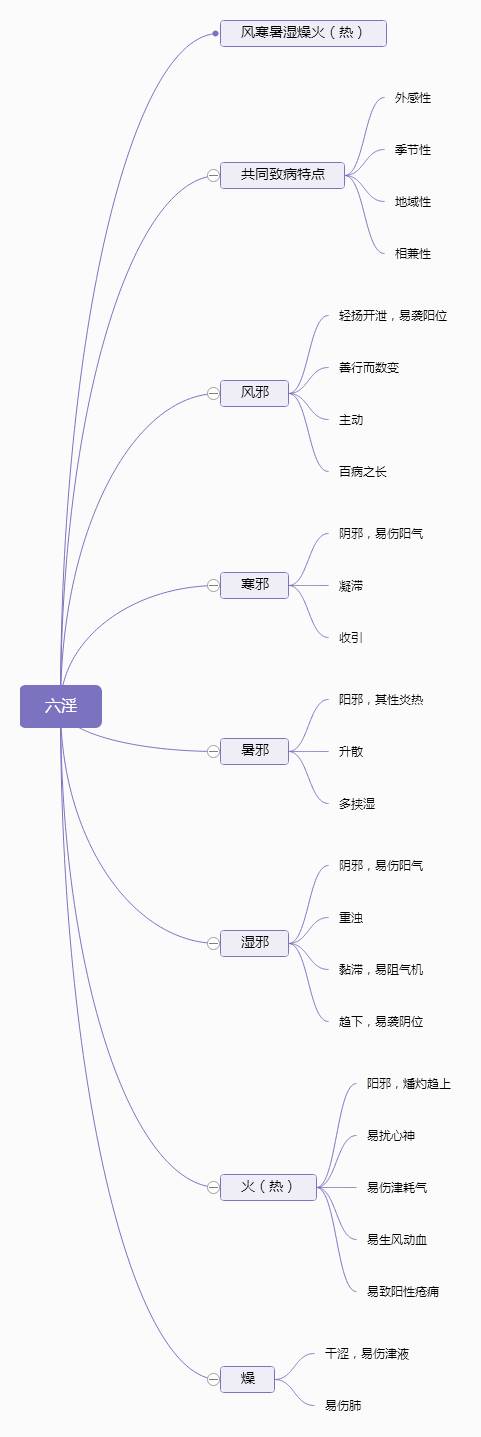
The Six Qi: The so-called Six Qi, also known as the Six Origins, refers to the six types of normal climatic conditions in nature: wind, cold, summer heat, dampness, dryness, and fire.
The Six Excesses: The so-called Six Excesses refers to the collective term for the six types of external pathogenic factors: wind, cold, summer heat, dampness, dryness, and fire.
General Characteristics of Pathogenic Effects of the Six Excesses
1. External pathogenic nature
2. Seasonal nature
3. Regional nature
4. Interrelated nature
Properties and Pathogenic Characteristics of the Six Excesses
1. Wind
(1) Characteristics: Wind has the properties of lightness, dispersion, and movement.
(2) Basic characteristics: Wind is light and dispersive, changes frequently, and is proactive, making it the leader of all diseases.
① Lightness and dispersion: Wind is a Yang pathogen, characterized by lightness and upward dispersal, which leads to its ability to easily harm the upper body, affecting the skin surface and areas of Yang such as the waist.
The lung is the canopy of the five organs and six bowels; if harmed, lung Qi cannot disperse, leading to symptoms such as nasal congestion, runny nose, and itchy throat with cough.
When wind disturbs the head and face, symptoms such as dizziness, headaches, neck stiffness, facial paralysis, and crooked mouth and eyes may occur.
When wind invades the muscle surface, symptoms like aversion to wind and fever may appear.
Due to its dispersive nature, wind can invade the muscle surface, causing the pores to open, leading to symptoms such as sweating and aversion to wind.
② Frequent movement: Wind is characterized by movement and instability, easily changing locations.
“Frequent movement” refers to the nature of wind pathogens being able to move without a fixed location, leading to symptoms that shift unpredictably.
For example, wind rashes and urticaria appear without a fixed location, coming and going;
wind bi (wind arthralgia) presents as migratory joint pain.
“Frequent changes” indicates that wind pathogens can cause sudden and unpredictable onset of disease.
For instance, wind rashes and urticaria may appear intermittently,
while conditions like epilepsy and stroke can lead to sudden fainting and loss of consciousness.
Generally, they exhibit characteristics of rapid onset, frequent changes, and quick transmission.
③ Proactive nature: “Proactive nature” means that wind pathogens have the characteristic of instability.
Common manifestations include dizziness, tremors, limb convulsions, opisthotonos, and upward gaze symptoms, hence the saying “when wind prevails, movement occurs.” For example, in external heat diseases, “extreme heat generates wind,” and in internal injuries, “liver Yang transforms into wind” or “blood deficiency generates wind” all exhibit the manifestations of wind disturbance.
④ Wind is the leader of all diseases:
Wind often combines with other pathogens to cause harm; it is the most common cause of disease.
2. Cold
(1) Characteristics: Cold has the properties of coldness, condensation, and contraction.
(2) Basic characteristics: Cold pathogens are characterized by coldness, stagnation, and contraction.
① Cold is a Yin pathogen, easily harming Yang Qi:
“When Yin is excessive, it causes cold,” “when Yin is excessive, it leads to Yang diseases.”
For example, if cold pathogens bind the surface, the defensive Yang is obstructed, leading to symptoms such as aversion to cold, fever, and absence of sweating, known as “cold damage.”
If cold pathogens penetrate internally, damaging the Yang Qi of the organs, it is referred to as “internal cold.”
If it harms the spleen and stomach, it leads to abnormal digestion and absorption, resulting in vomiting, diarrhea, and abdominal pain;
if the lungs and spleen are affected, it leads to cough and shortness of breath with clear phlegm or edema;
if cold harms the spleen and kidneys, it leads to failure of warming and transformation, resulting in aversion to cold, cold limbs, lower back pain, clear urination, loose stools, and edema.
If there is deficiency of heart and kidney Yang, and cold pathogens penetrate the Shaoyin, symptoms may include aversion to cold, curled up posture, cold hands and feet, diarrhea with clear stools, mental fatigue, and thin pulse.
② Cold nature causes stagnation:
Pain is an important characteristic of cold pathogens.
If cold invades the muscle surface, it causes severe pain in the head, body, and joints;
if cold penetrates internally, it leads to chest, epigastric, or abdominal pain or cramping.
③ Cold nature causes contraction:
Cold pathogens invading the body can cause Qi to contract, pores to close, and meridians and muscles to tighten;
if cold invades the meridians and joints, it leads to tightness and pain, making movement difficult or causing numbness;
if cold invades the muscle surface, it causes contraction of the pores, leading to fever and aversion to cold with absence of sweating.
Cold corresponds to the kidneys. Cold is water Qi, associated with the kidneys. When cold pathogens invade, excessive cold water leads to reduced urination, edema; excessive cold water can obstruct heart fire, leading to heart pain, palpitations, and cold limbs.
3. Summer Heat
(1) Characteristics: Summer heat is a fire-like pathogen.
(2) Basic characteristics: Summer heat is transformed from fire, primarily ascending and dispersing, often accompanied by dampness.
① Summer heat is hot:
Summer heat often manifests as a series of Yang heat symptoms, such as high fever, irritability, flushed face, restlessness, and a rapid pulse, known as heat stroke (or summer heat).
② Summer heat ascends and disperses: Ascending and dispersing refers to the tendency to rise and spread.
Ascending means summer heat easily invades the head and disturbs the heart spirit, as it easily enters the heart; dispersing means summer heat can harm fluids and exhaust Qi.
As summer heat is a Yang pathogen, it tends to rise, thus when it invades the body, it often directly enters the Qi level, causing the pores to open and leading to profuse sweating.
Excessive sweating can harm fluids, leading to symptoms such as thirst, dry lips, and scanty, dark urine.
With excessive sweating, Qi may also be lost, leading to symptoms of Qi deficiency, such as shortness of breath and fatigue, and in severe cases, sudden fainting and loss of consciousness due to heat stroke.
Heat stroke may also present with cold limbs, known as heat collapse. Summer heat can provoke liver wind, leading to symptoms such as limb convulsions, neck stiffness, and even opisthotonos, referred to as summer wind (heat convulsions).
Summer heat not only exhausts Qi and harms fluids but can also disturb the heart spirit, causing irritability and restlessness.
③ Summer heat often accompanies dampness:
Summer heat often combines with dampness. Clinical features include, in addition to fever and thirst associated with summer heat, often accompanied by symptoms of heaviness in the limbs, chest tightness, nausea, and loose stools.
4. Dampness
(1) Characteristics: Dampness has properties of heaviness, stickiness, and downward tendency.
(2) Basic characteristics:
Dampness is a Yin pathogen that obstructs Qi movement and easily harms Yang Qi, characterized by heaviness, stickiness, and downward tendency.
① Dampness is a Yin pathogen that obstructs Qi movement and harms Yang Qi:
The chest and flanks are pathways for Qi movement; dampness obstructs the chest, leading to chest tightness;
dampness hinders the spleen and stomach, causing them to fail in their functions, leading to symptoms such as poor appetite, lack of desire to eat, abdominal distension, and loose stools.
Dampness invading the body can lead to stagnation in the spleen, causing spleen Yang to be weak, leading to water retention, resulting in diarrhea, edema, and reduced urination.
“When dampness prevails, Yang is weak,” as dampness is a Yin pathogen that easily harms Yang Qi. To resolve dampness, methods to transform Qi and promote urination should be used to clear the Qi pathways and regulate water metabolism, allowing dampness to be expelled through urination, thus restoring Yang Qi.
② Dampness is heavy and turbid: Symptoms caused by dampness often have a heavy characteristic, such as heaviness in the head and body, and aching limbs.
If dampness invades the muscle surface, it can cause a feeling of heaviness and obstruction;
if dampness stagnates in the meridians and joints, it can lead to numbness of the skin and heavy joint pain.
The term “turbid” refers to filth and murkiness.
Thus, when dampness is present, it is common to see unclean excretions and secretions.
For example, if dampness is in the upper body, it may lead to facial blemishes and excessive eye discharge;
if dampness stagnates in the large intestine, it can lead to diarrhea with mucus and blood;
if dampness descends, it can lead to cloudy urine and excessive vaginal discharge;
if dampness invades the skin, it can lead to sores, eczema, and purulent discharge.
③ Dampness is sticky:
“Sticky” refers to the viscous nature; “stagnation” refers to obstruction. The sticky nature of dampness manifests in two main aspects:
First, the stickiness of symptoms: Symptoms of dampness are often sticky and uncomfortable, such as sticky stools, difficult urination, and viscous secretions, as well as a thick tongue coating.
Second, the lingering nature of the disease: Due to the sticky nature of dampness, it is difficult to resolve, leading to a slow onset and prolonged course of illness, often resulting in recurrent episodes or chronic conditions.
For example, damp-heat, eczema, and damp bi (damp arthralgia).
④ Dampness tends to descend:
Water tends to flow downward, and dampness is similar to water, thus dampness has a downward tendency, easily affecting the lower parts of the body. Symptoms are often seen in the lower body, such as edema, which is more pronounced in the lower limbs.
Other symptoms such as vaginal discharge, cloudy urine, diarrhea, and dysentery are also often caused by dampness descending.
However, dampness can invade both the upper and lower parts of the body, internally and externally, affecting all areas, not just the lower body. The saying “those harmed by dampness first suffer in the lower body” from the Su Wen (Plain Questions), “On the Taiyin and Yangming,” merely indicates that dampness tends to descend and easily invades Yin locations, which is one of its characteristics.
5. Dryness
(1) Characteristics: Dryness has properties of aridity, contraction, and cleansing.
(2) Basic characteristics: Excessive dryness leads to dryness, which easily harms the lungs, is the basic characteristic of dryness pathogens.
① Dryness injures fluids:
Dryness is transformed from the autumnal energy, characterized by dryness and desiccation, hence the saying “excessive dryness leads to dryness.”
Dryness harms the body by easily depleting bodily fluids, leading to various symptoms and signs of dryness, such as dry skin, cracked lips, dry throat, dry mouth, dry hair, scanty urination, and constipation.
② Dryness easily harms the lungs: The lungs are the canopy of the five organs and six bowels, favoring moistening and disliking dryness, hence they are called the delicate organ. The lungs govern Qi and respiration, directly connecting with the external atmosphere, and are associated with the skin and nose. Dryness often enters through the mouth and nose. Dryness is the main energy of autumn, corresponding to the lungs, thus dryness pathogens easily harm the lungs.
Dryness invading the lungs can damage lung fluids, leading to failure in dispersing and regulating, resulting in symptoms such as dry cough with little phlegm, or phlegm that is difficult to expectorate, or blood-streaked phlegm, and wheezing with chest pain.
6. Fire (Heat)
(1) Characteristics: Fire has the property of heat.
(2) The nature and pathogenic characteristics of fire pathogens: Fire pathogens have properties of burning, inflammation, Qi depletion, fluid damage, and blood movement.
① Fire is burning:
Fire pathogens cause disease primarily through excessive Yang Qi, clinically manifesting as high fever, aversion to heat, and a rapid pulse, indicating heat excess. In summary, fire heat as a disease is characterized by significant heat signs, such as fever and rapid pulse.
② Fire is inflammatory:
Fire is a Yang pathogen, characterized by upward movement. Thus, fire pathogens exhibit significant inflammatory characteristics, often manifesting in the upper body.
For example, if heart fire is blazing, symptoms may include red and painful tongue tips, oral ulcers, and sores;
if liver fire is blazing, symptoms may include severe headaches and red, swollen eyes;
if stomach fire is excessive, symptoms may include swollen gums and bleeding gums.
③ Damages fluids and depletes Qi:
In addition to significant heat signs, fire often accompanies symptoms of thirst, dry throat, scanty, dark urine, and constipation, indicating fluid depletion.
Qi is generated from water, and water can transform into Qi; when fire forces fluids to leak, the fluids become insufficient to generate Qi, leading to Qi deficiency,
such as in cases of severe fire heat, where alongside high fever, sweating, and thirst, one may also see fatigue and weakness.
In summary, fire pathogens can either directly harm the body’s righteous Qi or cause Qi damage due to fluid depletion, ultimately leading to the pathological result of fluid depletion and Qi exhaustion.
④ Causes wind and blood movement:
Fire pathogens can easily provoke internal wind and cause blood to move erratically.
Wind generation: When fire heat invades the body, it often burns the liver meridian, depleting fluids and blood, leading to internal wind movement, referred to as “extreme heat generates wind.” When wind and fire combine, symptoms can be acute, clinically manifesting as high fever, confusion, convulsions, neck stiffness, opisthotonos, and upward gaze.
Blood movement: Blood coagulates in cold and flows in warmth. Fire heat can burn the vessels and accelerate blood flow, leading to erratic blood movement, easily causing various bleeding symptoms, such as hemoptysis, epistaxis, hematochezia, hematuria, and skin purpura, as well as excessive menstruation and uterine bleeding in women.
⑤ Easily causes swelling and sores:
Fire heat entering the blood level can accumulate locally, leading to necrosis and pus formation, resulting in abscesses and sores. “Abscesses and sores originate from fire toxicity.” “Fire toxicity” and “heat toxicity” are common causes of sores, clinically characterized by localized redness, swelling, heat, and pain.
⑥ Easily disturbs the spirit:
Fire corresponds to the heart Qi, which governs blood vessels and houses the spirit. Therefore, when fire pathogens harm the body, they easily disturb the spirit, leading to symptoms such as irritability, insomnia, agitation, and even confusion and delirium.


